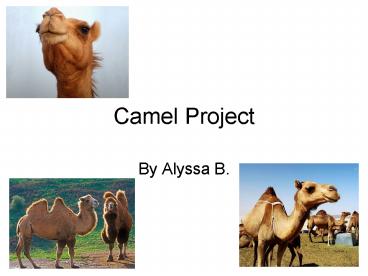Camel Project PowerPoint PPT Presentation
1 / 20
Title: Camel Project
1
Camel Project
- By Alyssa B.
2
Facts
- Every year in Saudi Arabia there is a beauty
contest to select the Prettiest Arabian Camel.
Judges look at the following qualities health,
the beauty of head, eyes, cheek-bones, legs,
humps, and affection to the owner. A winning
camel could be worth 500,000 United States
Dollars.
3
Facts
- The camels native to Saudi Arabia have one hump
and come in every shade of brown, from cream to
almost black. Contrary to popular belief, a camel
does not store water in its hump. It is in fact a
mound of fatty tissue which the animal draws
energy from when food is hard to find. They can
close their nostrils as protection against flying
sand and their ears are lined with fur to protect
their ear canal. Their eyes are shielded by a
double row of long curly eyelashes that keep out
sand and they have thick bushy eyebrows that
shield their eyes from the desert sun.
4
Facts
- Camel racing has been a traditional desert sport
of Bedouin tribes for many centuries. In the past
the race would involve thousands of camels
speeding across the open desert. Today the races
are held at the Riyadh Stadium on a large
circular track.
5
Facts
- Every February more than 2,000 Arabian Camels and
their young riders compete in 10 races during the
Al Janadriyah Cultural Festival. One or two races
are held each day for about a week. Gambling is
illegal in Saudi Arabia so there are no Betting
Booths in the stadium. Between 20,000 and 30,000
spectators usually attend the races.
6
Facts
- The camel trails up the Tuwaiq escarpment in
Saudi Arabia near Riyadh follow the natural water
course and were reinforced with small man-made
retaining walls. This camel trail was used to
ease the way of camel caravans traveling
east-west across the peninsula. The caravan would
be carrying not only traders with their goods but
also pilgrims headed toward Mecca.
7
Facts
- Im not sure if camels groom each other as some
animals do. The one humped dromedary camels are
native to Saudi Arabia. Their earthy coloring
ranges from a creamy white to all shades of brown
to almost black. These camels are perfectly
suited to the Arabian desert climate. They dont
actually store water in their humps, as many
people believe. In actuality, the hump is made of
fatty tissue which can supply the camel with
needed energy when food and water is scarce.
8
Facts
- Domesticated thousands of years ago by
frankincense traders, who trained the gangly
cud-chewer to make the long and arduous journey
from southern Arabia to the northern regions of
the Middle East, the camel went on to become the
desert dweller's primary source of transport,
shade, milk, meat, wool and hides. - Scientists believe that ancestors of the modern
camel lived in North America at least 40 million
years ago. Although the ancestors of the lamas
and camels appear to have diverged sometime in
the Eocene epoch, they weren't completely
separated from each other until the Pleistocene,
when the ancestors of the camels migrated across
the Bering Strait (temporary) land bridge to
Asia. Lamas migrated to South American, and all
camel died out in North America. Once in Asia,
camels migrated through eastern Europe, the
Middle East and North Africa - In Asia, two groups separated to become the two
chief types of camel known today the one-humped
or dromedary and the two-humped, shorter-legged
Bactrian camel. It is thought that the dromedary
may have evolved from the Bactrian camel.
However the hump(s) may have been acquired as a
result of domestication. The one-humped camel
(Camelus dromedarius ) is found in the Arabian
deserts, while the two-humped camel (Camelus
bactrianus ) is an Asiatic animal.
9
Pictures
10
Pictures
11
Pictures
12
Pictures
13
Funny Pictures
14
Funny Pictures
15
Funny Pictures
16
Funny Pictures
17
Funny Pictures
18
(No Transcript)
19
Other Parts
- Glogster
- http//sntod82.edu.glogster.com/edit/camel-project
/ - Wordle
20
Resources
- http//www.marisamontes.com/images/CavvyCamelWithM
outhOpenSmall.jpg - http//susieofarabia.wordpress.com/2008/06/12/came
ls-in-saudi-arabia/ - http//www.toursaudiarabia.com/trail.html
- http//en.wikipedia.org/wiki/Camel
- http//fohn.net/camel-pictures-facts/arabian-camel
s-2.html - http//righttruth.typepad.com/photos/uncategorized
/2008/03/19/camelface.jpg - http//delhi4cats.files.wordpress.com/2009/10/baby
-camel-787275.jpg - http//www.sciencedaily.com/images/2007/10/0710090
83359-large.jpg - http//3.bp.blogspot.com/_Od9Jxcuw998/SZR42P3wzDI/
AAAAAAAAG9w/9smAl05Dvco/s400/camel.jpg - http//charleykanesfunhouse.com/wp-content/uploads
/2009/11/funny-camel-picture-studies-show-2-of-3-c
amels-prefer-coke.jpg - http//mrbehi.blogs.com/i/images/camels.jpg
- http//4.bp.blogspot.com/_-GHCz55FydY/SbMfEyTrLwI/
AAAAAAAAArI/ZN7QWMVI20o/s400/subaruwithcamels.jp
g - http//farm3.static.flickr.com/2273/2119165627_9e6
b642916.jpg - http//www.bbc.co.uk/blogs/pm/images/camels.JPG
- http//www.thewilds.org/graphics/what/animals/bact
rian_camels.jpg

